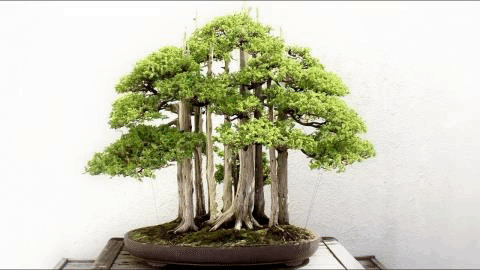Goji Berry: A Year of Growth [Bonsai]
The goji berry is one of the most unusual plants in my bonsai collection. View photos of this small tree during the height of the growing season.
Have you ever tried growing a fruit tree from dried fruit? Yes, you can do that. In fact, that is how I grew this small goji berry plant.
Goji berries have a tiny seed inside the dried fruit that is almost so small you do not see it or notice it when you eat it.
When given planted in the soil and given water, the berry starts to rot and mold, which are actually essential to trigger the young roots emerging from the seed to emerge.
As a bonsai tree in training, this goji berry is not the easiest tree to work with, because the stem is very long and fragile. I usually bring this tree indoors for the winter, but I think it is becoming more hardy, and it can probably handle some frost. The stems sometimes dieback if they have extended beyond the reach the roots can support. It looks like it can take years to build up a thick trunk.
Last year I kept it indoors all year long, and now it is enjoying full sun outside. I have a note in my action journal that this tree did lose all of its leaves shortly after it was moved outside because there was a week of dry heat. I was able to tease it into growing back because I covered it with a plastic bag to retain moisture, and I moved it to partial shade. As long as the root survives, goji seems to be a tough one to kill.
Goji tends to grow into a long upright vine until it becomes so heavy that the stem tips over to lay down on the ground. New stems eventually form along the nodes of the old stem. The sunlight invigorates the topmost nodes closest to the root to grow first, and the process of developing a long new upward stem starts over. This is how the plant spreads out in nature.
One of the benefits of goji as a bonsai is that the long branches grow quickly, and this makes them easy to train on a wire. Although branches are flexible, they are slightly tender and can snap if forced into too deep of a fold, so use a delicate hand with a thin wire. I was able to create these fun zig-zag branches at the base merely by allowing the pot to constrain its growth pattern. Sometimes I can create fun shapes by covering the tree in a clear plastic cup to trap the branches and force them to turn.
Gojis are an invasive plant in some cases. The stems, when they fall over or break off will self-root, and produce additional plants. Suckers can also appear out of the soil anywhere the root has spread.
There are also less invasive varieties of the goji that can also be purchased from plant nurseries. They might have other good properties to give the fruit better flavor, or make them taste better for drying out or eating fresh.
Last year I started growing a second goji berry tree from a cutting of this one, because I wasn't sure how long it would live. Now I have too very healthy looking goji trees in my collection.
Historical Information
ID: 0033
Nickname: Unnamed
Type: Goji Berry
Age: 1.5 years
Grown: seed (from dried fruit)
Last repotting: Never
Wired: Never
Past articles featuring this tree by @creativetruth:
Be sure to follow my work this week. I'm in the process of sharing the whole host of bonsai trees in my collection. There is over thirty trees I am growing. That means you can enjoy more than a month of fresh content from @creativetruth's back porch.
Share the goodness with me.
Photos in this post are all #originalworks by @creativetruth, unless stated otherwise.
Find me on discord and chat with other tree growers, bonsai enthusiasts, and gardeners. We have quite a few accredited experts filling out our ranks, and a helpful Spanish-speaking community.

#goji #goji-berry #fruit-tree #shrub #berry-bush #superfood #bonsai-tree #seed #propagation







